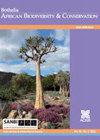标题苋菜亚科首次记录。warnockii (I.M.Johnst)。N.Bayón(苋菜科)美洲以外的,有命名注释
IF 0.5
4区 生物学
Q4 PLANT SCIENCES
引用次数: 0
摘要
背景:苋菜属因其形态的高度变异而在分类学上很复杂,这导致了命名上的混淆、名称的误用和误认。遗憾的是,该属的区系和分类学研究仍不完整。标题苋菜亚属一个居群。warnokii是在突尼斯的Monastir省被发现的,代表了突尼斯和非洲植物区系的第一个记录,也是第一个在其美洲本土分布地区之外的记录。目的:本研究的主要目的是记录苋菜亚种。warnockii (I.M.Johnst)。在突尼斯和非洲首次登陆N.Bayón。提供了形态特征和生态资料。并对苋菜、苋菜、苋菜的分类进行了澄清。方法:通过实地调查、文献分析和对美国纽约GH、HAL、P、RO标本馆和莫纳斯提尔大学药学院标本馆保存标本的检验。结果:为Schlechtendal的A. crassipes提供了命名注释(HAL的选型,由Henrickson于1999年指定,但此处根据ICN第9.10条进行了更正);Schrader的amaranthoides[一个多余和非法的名称(ICN第52.1和52.2条),并被认为是a . crassipes s.str.的同型同义词];以及Moquin-Tandon的maranthoides[无效名称(ICN第36.1条)]。结论:苋菜属;warnokii是突尼斯的一种外来物种,生长在人造栖息地的粘土和沙质基质上,在原始植被中,它可以被认为是一种偶然的物种。我们希望今后对该种群进行持续监测,以核实该分类群在突尼斯可能的归化和扩散。如果发生后一种情况,就需要采取根除这些植物的行动。本文章由计算机程序翻译,如有差异,请以英文原文为准。
First record of Amaranthus crassipes subsp. warnockii (I.M.Johnst.) N.Bayón (Amaranthaceae) outside of the Americas, with nomenclatural notes
Background: The genus Amaranthus is taxonomically complex because of its high morphological variability, which led to nomenclatural confusion, misapplication of names and misidentifications. Unfortunately, floristic and taxonomic studies on this genus are still incomplete. A population of Amaranthus crassipes subsp. warnockii was discovered in Monastir Governorate, Tunisia, representing the first record for both the Tunisian and the African floras, as well as the first one outside of its American native distribution area.
Objectives: The main aim of the present study was to record Amaranthus crassipes subsp. warnockii (I.M.Johnst.) N.Bayón in Tunisia and Africa for the first time. Morphological characters and ecological data were provided. Clarification about the typification of the names Amaranthus crassipes, A. warnockii and Scleropus amaranthoides was also presented.
Methods: The work was based on field surveys, analysis of relevant literature and examination of specimens preserved in the herbaria GH, HAL, P, RO, NY, US and the Herbarium of the Faculty of Pharmacy of Monastir (Monastir University).
Results: Nomenclatural notes were provided for Schlechtendal’s A. crassipes (lectotype at HAL, designated by Henrickson in 1999 but here corrected according to Art. 9.10 of the ICN); Schrader’s Scleropus amaranthoides [a superfluous and illegitimate name (Arts. 52.1 and 52.2 of the ICN) and regarded as a homotypic synonym of A. crassipes s.str.]; and Moquin-Tandon’s Scleropus amaranthoides [an invalid name (Art. 36.1a of the ICN)].
Conclusion: Amaranthus crassipes subsp. warnockii is an alien species in Tunisia, growing in human-made habitat on clayey and sandy substrates within ruderal vegetation where it can be considered a casual. We hope that in the future continuous monitoring of the population will take place, to verify the possible naturalisation and spread of this taxon in Tunisia. If the latter happens, actions for eradication of the plants are needed.
求助全文
通过发布文献求助,成功后即可免费获取论文全文。
去求助
来源期刊

Bothalia
生物-植物科学
CiteScore
1.70
自引率
0.00%
发文量
12
期刊介绍:
Bothalia: African Biodiversity & Conservation is published by AOSIS for the South African National Biodiversity Institute (SANBI) and aims to disseminate knowledge, information and innovative approaches that promote and enhance the wise use and management of biodiversity in order to sustain the systems and species that support and benefit the people of Africa.
The journal was previously published as Bothalia, and had served the South African botanical community since 1921. However the expanded mandate of SANBI necessitated a broader scope for the journal, and in 2014, the subtitle, African Biodiversity & Conservation was added to reflect this change.
 求助内容:
求助内容: 应助结果提醒方式:
应助结果提醒方式:


